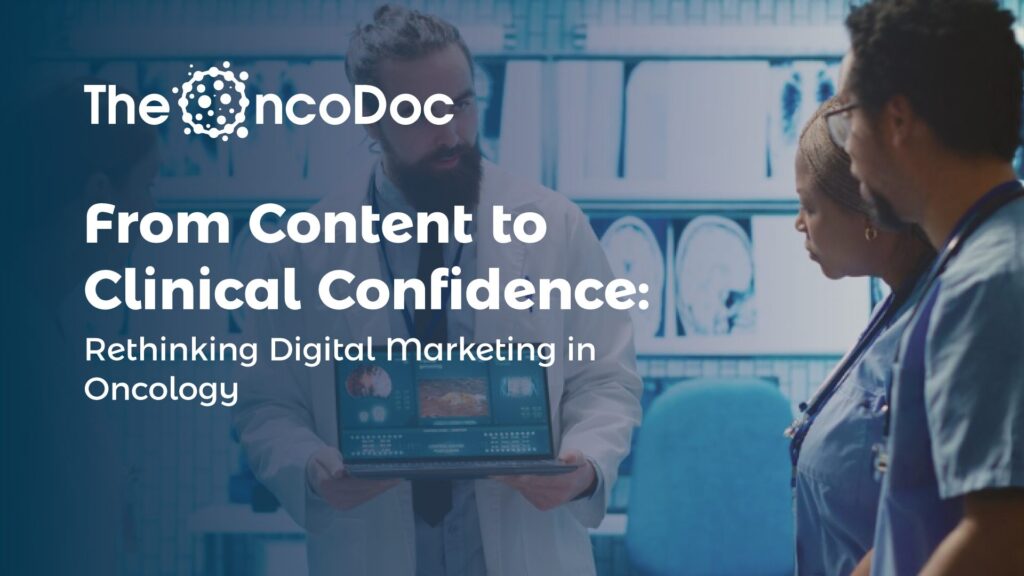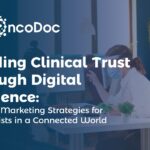Introduction: More Than Messaging-A Mandate to Support Oncology Practice
As the role of digital channels in healthcare continues to expand, pharma brand managers face a growing imperative: to create content that doesn’t just inform but actively supports clinical practice. In oncology, where decisions are high-stakes and time-sensitive, traditional metrics like reach or impressions no longer reflect campaign success.
Instead, the focus must evolve toward value-based digital strategies approaches that help oncologists simplify complex decisions, improve patient communication, and strengthen therapeutic confidence.
This article outlines how pharma marketing leaders can design and deliver digital campaigns that aren’t just visible but truly valuable in everyday oncology care.
1. Empower Oncologists with Smart, Structured Content
Today’s oncologist is bombarded with information emails, webinars, notifications but only a fraction of it earns attention. What breaks through the noise is content that delivers utility at the point of care.
Oncologists now seek:
- Treatment pathway tools that help match the right drug to the right stage and biomarker profile
- Side effect management checklists they can reference mid-consult
- MOA (Mechanism of Action) visuals to simplify new therapy discussions
- Slide decks and summaries ready for tumour boards
- Patient communication guides for consent, prep, and follow-up

2. Distribute Where They’re Already Looking
A key factor in digital strategy success is channel optimization. Even the best content will fail if it doesn’t reach oncologists in the right moment and format.
Preferred distribution methods:
- Email still dominates for in-depth assets like PDFs and toolkits
- WhatsApp has become a go-to for quick, high-frequency updates
- LinkedIn is effective for expert opinions and short clinical reflections
- Doctor platforms and mobile apps work best for tool integration and resource libraries

3. Think Small, Think Smart: Micro-Content with Maximum Impact
In oncology, physicians juggle complexity every day. That’s why long webinars and clinical articles are being replaced by micro-content-bite-sized assets that deliver clarity in under 90 seconds.
What works best:
- 1-minute videos on biomarker selection
- 2-slide summaries of treatment updates
- Infographics comparing efficacy curves
- Voice-note explainers from KOLs via messaging apps
This kind of modular content fits into the oncologist’s workflow, not just their inbox. It builds familiarity and trust over time.
4.Bridging Gaps with Peer-to-Peer Digital Communities
Beyond static content and one-way communication, oncologists increasingly seek peer validation and real-world perspectives to inform their practice. Digital marketing strategies that facilitate community-driven engagement; such as moderated discussion groups, clinical polls, and expert panels,offer immense value.
These digital communities not only humanize the brand but serve as continuous learning platforms. For example, a weekly poll on treatment preferences in specific subtypes can spark debate, surface practice patterns, and keep the brand top-of-mind without overt promotion. Similarly, spotlighting ‘case of the month’ discussions with Indian oncologists adds relatability and practical context to clinical decision-making.
Creating these interactive spaces, whether hosted on existing doctor platforms or in closed WhatsApp groups, turns content consumers into contributors. It builds brand affinity while enabling shared learning a win-win for pharma and HCPs.
5.From Educators to Enablers: Help Them Help Patients
Oncologists aren’t just treating diseases they’re guiding patients and families through some of life’s most difficult journeys. Pharma can play a powerful role by equipping HCPs with shareable, multilingual patient materials.
Useful assets include:
- Short explainer videos on immunotherapy and targeted therapy
- Printable chemotherapy prep checklists
- Regional-language consent and FAQ templates
- Digital caregiver toolkits to reduce anxiety and improve adherence
These aren’t just feel-good add-ons they reduce consult time, boost understanding, and enhance patient satisfaction.
6. Transparency Isn’t Optional ,It’s the Standard
Trust is everything in oncology. Your digital presence must reflect scientific transparency and local relevance at every step.
Best practices:
- Always pair benefits with known side effects
- Share Indian regulatory status (e.g., DCGI approvals) clearly
- Include quotes, faces, and input from Indian oncologists not stock imagery
- Tailor messaging by sub-specialty (e.g., breast, lung, GI)
Avoid exaggeration or overly polished messaging. Authenticity is what earns re-engagement.
7. Support Field Reps Through Digital Intelligence
Digital and field teams can no longer operate in silos. When done right, digital marketing enhances rep productivity by making interactions more personalized and clinically aligned.
What works:
- Sharing open-rate data with reps for better targeting
- Using digital downloads to trigger in-person follow-ups
- Providing real-time dashboards on regional engagement trends
This creates a closed feedback loop between content performance and field activity, enabling smarter outreach.
8.Enhancing Personalization Through Clinical Journeys
One-size-fits-all digital campaigns no longer serve the nuanced needs of oncology professionals. Personalization should move beyond name-tagging emails to truly reflect the clinical context. Mapping digital content to specific stages in the oncology care continuum such as diagnosis, first-line therapy, progression, and survivorship ensures that each touchpoint delivers relevance.
For example, a breast cancer specialist managing post-surgical care may benefit more from recurrence monitoring tools than broad immunotherapy updates. Delivering such tailored assets improves engagement and aligns digital interactions with real-world decision-making.
Dynamic content sequencing and CRM-linked insights can automate this level of personalization at scale, making campaigns more efficient and impactful.
9.Rethink Success: Measure What Actually Matters
The true success of an oncology campaign isn’t in the number of impressions it’s in the clinical behaviors it enables. Did the oncologist reuse your tool? Share it with a peer? Discuss it with a rep?
Start tracking:
- Monthly repeat usage of clinical assets
- Minutes spent on specific resources
- Number of content shares within peer networks
- Rep meeting requests triggered by digital engagement
- Post-engagement surveys: “Did this improve your practice?”

Mini Case Study: A Digital Campaign That Delivered
Objective: Support the launch of a new oral chemotherapy agent for metastatic colorectal cancer.
Digital Strategy:
- Created a mobile-friendly treatment sequence tool
- Designed a visual MOA explainer for rep use
- Deployed content via LinkedIn, WhatsApp, and regional portals
- Embedded follow-up triggers into CRM for real-time rep action
Results:
- 48% of targeted oncologists used the sequencing tool at least twice/month
- WhatsApp video view rate exceeded 72%
- 1 in 3 engagements led to field rep follow-up
By aligning digital and field forces around clinical enablement, the brand became not just recognized but respected.
Conclusion: Digital That Serves the Practice Wins the Market
The future of oncology marketing doesn’t belong to brands that shout the loudest it belongs to those who show up with clinical value, every time.
To succeed, digital pharma teams must:
- Deliver tools that assist in everyday decision-making
- Respect HCP time with smart, short-form content
- Personalize by sub-specialty and regional needs
- Align metrics with outcomes, not impressions
Final Thought:
In oncology, every message matters. When digital campaigns are designed to support; not sell, they become part of the treatment journey itself.
The Oncodoc team is a group of passionate healthcare and marketing professionals dedicated to delivering accurate, engaging, and impactful content. With expertise across medical research, digital strategy, and clinical communication, the team focuses on empowering healthcare professionals and patients alike. Through evidence-based insights and innovative storytelling, Hidoc aims to bridge the gap between medicine and digital engagement, promoting wellness and informed decision-making.



